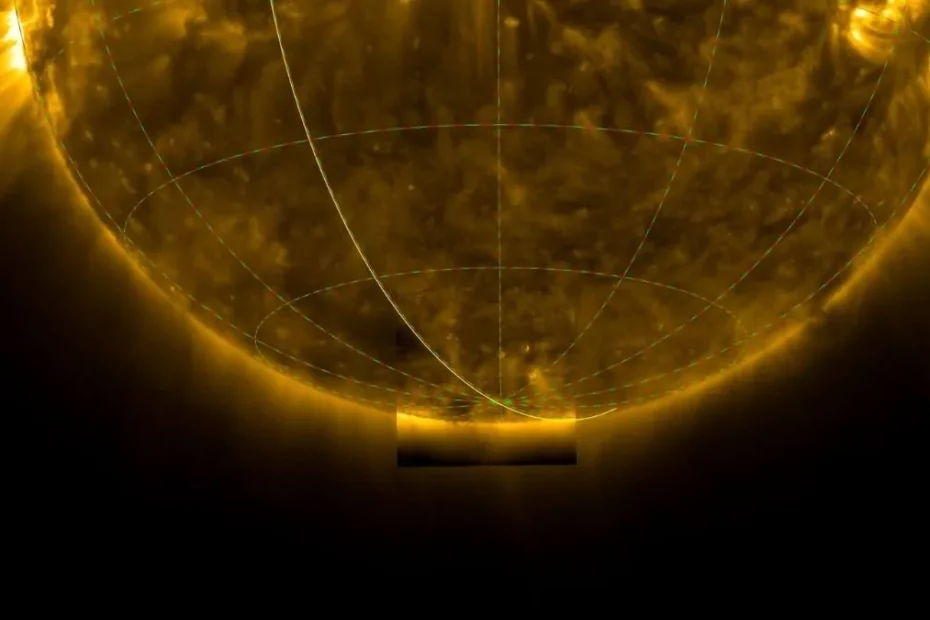In a major leap for solar science, humanity has laid eyes on the Sun’s elusive south pole for the first time — thanks to the European Space Agency’s Solar Orbiter spacecraft. The newly released images and data are already transforming how scientists understand solar storms, space weather, and the magnetic forces that shape our solar system.
Launched in 2020 as a joint mission by ESA and NASA, the Solar Orbiter is now tilted just enough — about 17 degrees below the Sun’s orbital plane — to capture high-resolution images of a region no telescope on Earth has ever seen.
Why the South Pole Matters More Than You Think
What’s so special about the Sun’s poles?
Quite a lot, it turns out.
The Sun’s magnetic poles flip roughly every 11 years, unleashing chaotic storms and solar winds that can disrupt satellites, GPS, and even power grids on Earth. Until now, researchers lacked direct data on how magnetic fields behave at the poles — the very engines behind these space weather events.
“This is the missing piece we’ve been waiting for,” said Prof. Lucie Green of University College London. “We can finally see how the Sun’s magnetic fields migrate to the poles — a crucial step in forecasting future solar storms.”
First Images: A Turbulent, Fiery Landscape
The south pole images, taken between March and June 2025, show a glowing plasma atmosphere, laced with massive loops of gas and twisted magnetic fields. The temperature in some regions hits a staggering one million degrees Celsius, while cooler areas still burn at over 100,000 degrees.
To the naked eye, the Sun appears as a flat yellow disk. But the Orbiter’s specialized instruments — especially one called SPICE — reveal a dynamic, fluid world of energy, motion, and power.
“These are the sharpest, most detailed images we’ve ever seen of the Sun’s polar regions,” said ESA Science Director Carole Mundell. “They’ll change how we model the Sun forever.”
Advertisement
Space Weather: From Mystery to Forecastable Science
The ability to study the Sun’s south pole isn’t just a win for astronomy — it could soon impact daily life on Earth.
Every time the Sun hurls a solar flare or coronal mass ejection toward our planet, it threatens to interrupt telecom signals, knock out satellites, or damage power grids. But with these new measurements, scientists may finally be able to predict such outbursts before they happen.
“The polar magnetic fields are the key to understanding when and why the Sun erupts,” said Prof. Christopher Owen, who studies solar wind patterns. “With this data, we’re closer than ever to forecasting space weather like we do Earth’s weather.”
What’s Next for Solar Orbiter?
As the mission continues, the Orbiter will tilt even higher — providing unprecedented views of both poles. ESA says images of the Sun’s north pole have already been captured and are en route back to Earth.
These findings will also help fine-tune AI-powered simulations of the Sun’s interior and magnetic structure. With accurate models, scientists can provide early warnings for solar storms — and yes, even help aurora chasers catch the next big display.
A Space Age Twist: Why This Story Belongs with the Galaxy S25 Edge
You might be wondering: what does the Samsung Galaxy S25 Edge have to do with the Sun’s south pole?
Plenty — if you’re thinking about the future.
Just like Solar Orbiter’s tilt gave us a new angle on the Sun, Samsung’s S25 Edge is pushing boundaries here on Earth. With its ultra-thin 5.8mm titanium body and advanced solar radiation shielding for device circuits, the phone is built for a future shaped by tech and space science alike.
Both are designed for exploration — one beyond Earth, the other right in your palm.
We are witnessing the dawn of a new era in solar physics. With each image, Solar Orbiter is not just reshaping textbooks — it’s giving us the tools to protect Earth from space-based threats. And for the first time, the south pole of our life-giving star is no longer a mystery.
